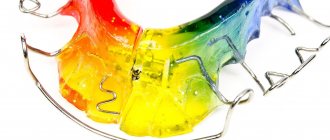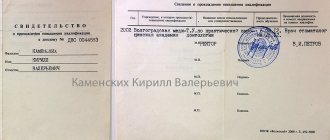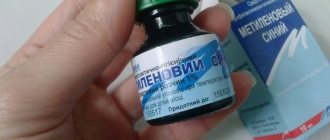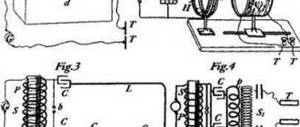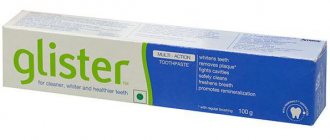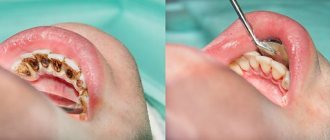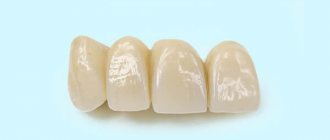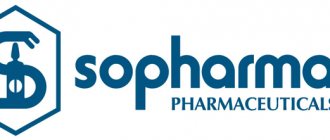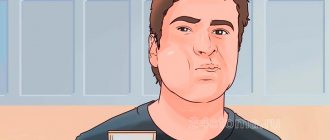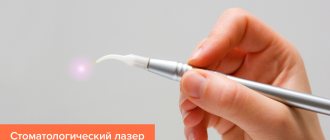Description of the drug and its composition
“Orablok” is a modern anesthetic based on the active substance “articaine”, as well as with adrenaline (epinephrine) in its composition. The latter is a vasoconstrictor, that is, it has a vasoconstrictor effect, which enhances and prolongs the analgesic effect. Articaine belongs to the amide type of anesthetic - it is significantly more effective than novocaine.
"Orablock" is a modern anesthetic based on the active substance "articaine"
1 ml of solution contains 40 mg of the main active ingredient and 5 μg of epinephrine. There is also a solution in a higher concentration of adrenaline - 10 mcg/ml with 40 mg of articaine. The effect occurs quickly - within 1-3 minutes. The duration of action is at least 45 minutes for a standard concentration and at least 75 minutes for a solution with a high content of epinephrine.
Indications for use
The drug is used for local infiltration or conduction anesthesia in dentistry. A solution with an epinephrine concentration of 5 mcg/ml is used for standard medical procedures, for example, for filling carious cavities, uncomplicated tooth extraction, and grinding crowns for a prosthesis.
“I had a tooth pulled under an orablock, everything went fine, I didn’t feel anything. Yes, it was unpleasant to feel that a tooth was being tossed around in your mouth, but what can you do? By the way, the freeze went away, after an hour I could feel my tongue, I was eating and drinking calmly. As for me, normal good anesthesia. As soon as I remember what they made for us in childhood, there’s no comparison! Then there was a freeze, there wasn’t.”
KirilZaz, from correspondence on the forum www.32top.ru
The drug can be used in dental treatment.
Orablock with an increased concentration of epinephrine is used for more serious interventions. Such procedures include operations on mucous and bone tissue. This anesthetic is also used in the treatment of teeth with pulpitis (inflammation of the dental nerve) and if complex removal is required, including eights (wisdom teeth), resection of the root apex, implantation, and other surgical interventions.
Evaluation of the effectiveness of the use of articaine anesthetics “Brilocaine” and “Septanest”
Most therapeutic interventions in the maxillofacial area are accompanied by pain of varying degrees of intensity, so high-quality pain relief during their implementation is an urgent problem in dentistry. Improving dental care for the population is impossible without the introduction of effective modern anesthetics into everyday practice. Today, the interchangeability of drugs is one of the most serious controversial issues both in Russia and throughout the world. According to experts, the production of generics is the most important and leading strategic direction for the development of the pharmaceutical industry, which will continue in the next decade.
An original drug is a new drug, synthesized for the first time and undergone a full cycle of research, the active ingredients of which are protected by a patent for a certain period, and significant intellectual and material resources have been spent on development, clinical trials, production and introduction to the market. Generic is a reproduced medicinal product, similar to the patented (original) one and introduced to the market after the patent protection period of the original has expired.
The algorithm for the production process of generic and original pharmaceuticals is the same and meets WHO requirements, which regulate strict standards in terms of premises, equipment, raw materials, personnel, quality control methods, etc. However, the procedure for registering generics is much cheaper and takes less time, since it does not require a full cycle of clinical trials.
Currently, there are a sufficient number of original drugs and generics of the articaine series on the domestic dental market. Brilocaine is a combination drug for local anesthesia in dentistry.
Indications for use: infiltration and conduction anesthesia, including in patients with concomitant somatic pathology.
Contraindications for use:
- hypersensitivity to articaine, adrenaline, sulfites, auxiliary components of the drug;
- bronchial asthma with hypersensitivity to sulfites;
- porphyria, hyperthyroidism, angle-closure glaucoma, paroxysmal tachycardia, atrial fibrillation, simultaneous use of non-selective b-blockers.
Purpose of the study
To evaluate the effectiveness of using the anesthetic "Brilocaine" at a dental appointment.
Materials and methods
In January-March 2015, 22 dentists were surveyed. All of them are employees of municipal dental clinics in Volgograd. To assess the effectiveness of pain relief, subjective and objective indicators characterizing the intensity of pain in the patient were studied. For this purpose, visual analogue scales were used, which are widely used in clinical consultations. Each time after using the anesthetic Brilocaine, dentists assessed the quality of work with it.
Results and its discussion
The majority of procedures performed using the anesthetic Brilocaine were dental treatment – 55.2%. Dentists also used the drug for extraction of teeth under infiltration and conduction anesthesia (22.6% and 9.5%, respectively), preparation of teeth for artificial crowns under infiltration anesthesia (13.5%), performing operations on the soft tissues of the maxillofacial area and interventions on the oral mucosa. At the same time, 84.4% of respondents rated the analgesic activity of the anesthetic as high (the onset of anesthesia from the moment of administration is 1–3 minutes, high-quality anesthesia throughout the entire intervention), 9.3% of respondents considered the activity of Brilocaine to be average (slower achievement of the anesthetic effect by compared with other articaine anesthetics). And only in every 16th case of using Brilocaine, anesthesia came on slowly, the first injection was not enough (6.2%).
The majority of doctors (87.5%) calmly performed the manipulation; in 6.2% of cases, the patient experienced slight pain during treatment, but no additional administration of the drug was required. Also, 6.2% of dentists reported that the patient experienced pain during treatment and required additional administration of the drug (Fig. 1). Assessing what exactly could have influenced the weak anesthetic activity of Brilocaine, respondents noted the neglect of the inflammatory process, accompanied by a deterioration in the general condition of the body and the individual characteristics of the emotional sphere of patients who were anxious before starting treatment.
Fig. 1. The effectiveness of manipulation using the anesthetic “Brilocaine”
Most dentists, when choosing medications, preferred original drugs (82.4%), 12.5% did not see the difference, and only 5.1% of respondents chose generics, which indicates doctors’ distrust of domestically produced drugs.
Of the adverse reactions accompanying the administration of the anesthetic Brilocaine, 2.7% of respondents noted an increase in heart rate (Fig. 2), which is comparable with the data of I.V. Fomichev, obtained during a study of the drug Septanest in 2014. All doctors who took part in the survey denied the occurrence of any technical difficulties during anesthesia.
Fig 2. Adverse reaction during or after the use of the anesthetic "Brilocaine"
When making injection solutions, all manufacturers take measures to ensure the safety of medicinal substances, use preservatives and stabilizers of the active substance: EDTA, HCl solution, glycine, etc. EDTA is a complexing agent that captures metal ions (Al, Pb) leached from glass, and removes it from the body. There is an assumption that the presence of EDTA in the anesthetic can cause headache, nausea, vomiting, local tissue irritation, kidney damage, and heart rhythm disturbances. Allergic reactions to EDTA with topical application of corticosteroids have also been described. Confirmation or refutation of these statements is not required, since Brilocaine does not contain EDTA, HCl and glycine. The preparation uses Trilon B (disodium salt of EDTU) and chemically resistant glass. Possible adverse reactions are also reduced by the absence of parabens in Brilocaine.
conclusions
Analysis of the results showed that in all cases of use of Brilocaine, the drug was well tolerated, and high-quality anesthesia was achieved during conduction and infiltration anesthesia. The absence of a number of potentially allergenic components in the anesthetic makes it possible to reduce the risk of adverse reactions during anesthesia at an outpatient dental appointment. Generic Brilocaine has all the properties of the original drug. The data obtained were comparable to the results of clinical studies of the anesthetic “Brilocaine” and similar articaine-containing drugs conducted at the Moscow State Medical University. A comparative study of the effectiveness of pain relief and the safety of the anesthetic “Brilocaine-adrenaline forte 1:100000” suggests that in the outpatient treatment of dental diseases it has clinical and physiological parameters similar to similar articaine-containing drugs.
This is a digest of an article by Volgograd researchers: Chief Physician A.V. Mikhalchenko , Candidate of Medical Sciences Associate Professor D.V. Mikhalchenko , Doctor of Medical Sciences, Head of Department Assistant V.N. Naumova , Candidate of Medical Sciences Dentist E.A. Filyuk Department of Propaedeutics of Dental Diseases of Volgograd State Medical University (Volgograd) of the Ministry of Health of the Russian Federation.
The original article can be read on the website: https://ferain.ru/company/smi/443.html
In what cases is Orablok contraindicated?
Since it is an anesthetic and is classified as a drug, its use may also be limited by certain individual characteristics of the patient's body or pathological conditions. Thus, among the main contraindications, experts highlight intolerance to articaine and other components in the composition, severe pathologies of the heart and blood vessels. The drug is not used if the patient has hypotension, anemia, or a recent history of heart attack.
The drug is not used in the presence of certain serious diseases
Instructions and recommended dosages
To carry out standard medical procedures, 1.8 ml of solution is administered. If simple tooth extraction is planned, the appropriate dosage is indicated for each tooth. Sometimes, to enhance the effect, it is necessary to additionally inject from 1 to 1.8 ml - at the discretion of the specialist. For painless incisions in the palate and suturing, 0.1 ml is enough. The drug allows extraction of lower premolars under infiltration anesthesia with the introduction of an anesthetic in a dosage of 1.8 ml.
As part of filling or preparing teeth for dentures (except for lower molars), it is recommended to administer from 0.5 to 1.8 ml (infiltration anesthesia). The dosage is selected based on the planned depth of grinding of hard tissues and the expected duration of the procedure. But for more complex surgical procedures, as mentioned above, preference should be given to Orablock with an epinephrine concentration of 10 mcg/ml. The dosage is selected individually.
The dosage of the drug is selected individually
The drug is also used in pediatric dentistry, but here everything depends directly on the age of the child and the approximate weight of his body. The instructions for use provide the following guidelines:
- from 4 to 12 years – no more than 5 mg of articaine per 1 kg of weight,
- if body weight is from 20 to 30 kg - 0.25-1 ml of solution, but not more than 1.5 ml at a time. No more than 2.5 ml per day,
- with a weight of 30 to 45 kg - 0.5-1.7 ml, but not more than 1.7 ml at a time. The permissible daily dosage is 5 ml.
There are also special instructions for elderly patients. If there is a history of impaired liver and kidney function, the concentration of articaine in the blood plasma may increase. Therefore, in relation to this category of patients, the anesthetic should be used with extreme caution and in minimal dosages.
Septanest with Adrenaline
When the first signs of a side or toxic effect (dizziness, restlessness, impaired consciousness) appear, it is necessary to immediately stop the injection and place the patient in a horizontal position. Careful monitoring of hemodynamic parameters (pulse, blood pressure) and airway patency is necessary. Even if the symptoms do not seem severe, you should prepare everything necessary for an intravenous infusion and, at the very least, perform a venipuncture. Depending on the degree of respiratory impairment, oxygen should be given, artificial respiration (mouth-to-nose) and, if necessary, endotracheal intubation with controlled ventilation. The use of centrally acting analeptic drugs is contraindicated. For involuntary muscle twitching or generalized convulsions, intravenous administration of short-acting or ultra-short-acting barbiturates is indicated. Administration should be carried out slowly, under constant monitoring of hemodynamics and respiration. At the same time, intravenous fluid infusion should be administered through a pre-installed cannula. The patient should also be given oxygen.
In case of tachycardia, bradycardia or a marked decrease in blood pressure, the patient should be placed in a horizontal position with legs elevated. In case of severe circulatory disorders and shock, the injection of the drug should be stopped. Provide the patient with a horizontal position with elevated legs, perform oxygen inhalation and intravenous infusion of balanced electrolyte and plasma-substituting solutions, and administer glucocorticoids intravenously (250-1000 mg of methylprednisolone). In case of threatening vascular collapse and increasing bradycardia, administer intravenously 25-100 mcg of adrenaline (0.25-1.0 ml of a solution with a concentration of 100 mcg/ml). The administration is carried out slowly, under the control of pulse and blood pressure. Do not administer more than 100 mcg of adrenaline (1 ml of solution once). When administering additional amounts of adrenaline, it should be added to the infusion solution. The rate of infusion should correlate with heart rate and blood pressure levels.
Severe forms of tachycardia and tachyarrhythmia can be eliminated by the use of antiarrhythmic drugs, however, non-selective beta-blockers should not be used.
In these cases, it is necessary to use oxygen and monitor hemodynamic parameters. If blood pressure increases in patients with arterial hypertension, peripheral vasodilators should be used, if necessary.
Is it possible to use an anesthetic during pregnancy and lactation?
There is no confirmed clinical data on the safety of using Orablock during pregnancy, so this anesthetic cannot be freely recommended for pregnant patients. On the other hand, there are no facts confirming its adverse effects on the body of the expectant mother and baby1. Therefore, the use of this drug is possible in the absence of other alternatives or at the discretion of the attending physician, but with extreme caution. In such a situation, it is better to give preference to a solution with a lower concentration of epinephrine - 5 mcg/ml.
The drug is not used during pregnancy
There is not yet sufficient clinical data on the negative effects of articaine when it penetrates the placenta, in fact, as well as confirmed information about its safety. Therefore, after using the solution, you should stop breastfeeding for a while.
General and local anesthesia
What is used for pain relief in dentistry today? Two types of anesthesia are used - general (anesthesia) and local. The first type is rare and is used for extensive jaw surgeries. Anesthesia has a large number of contraindications and possible complications, and therefore in modern clinics the choice is in favor of local anesthesia. Moreover, its current level allows us to comfortably carry out treatment of caries, pulpitis, tooth extraction, prosthetics and other work.
Local anesthesia involves anesthetizing the area of intervention - turning off pain sensitivity, the patient is conscious. In most cases, tactile sensitivity is preserved (touching the cheek, gum, tooth, sensation of vibration, and so on).
The following types of anesthesia are used in dentistry:
- Applique . Only the mucous membrane is anesthetized using a special spray or gel. The rapid anesthetic effect allows further injection without pain. Used for removing stone and interventions at the gingival margin.
- Infiltration . An injection into the gum for pain relief in the upper jaw. The injection begins to act within 3-4 minutes, the freezing lasts for about an hour. Infiltration anesthesia is used in the treatment of pulpitis, deep caries, and tooth extraction. Complete absence of pain during treatment.
- Conductor . Anesthesia of the lower tooth, injection of an anesthetic into the area of the mandibular nerve. The nerve impulse along a fairly large cluster of nerves is blocked, and therefore the tongue and part of the lower jaw become numb. Naturally, anesthesia has a reversible effect and the nerve tissue is not damaged. The effect lasts for about two hours. Intraligamentary. Intraligamentous anesthesia, unlike conduction anesthesia, does not cause numbness of the tongue and part of the jaw, and therefore is actively used in pediatric dentistry when treating cavities and removing teeth. In adult patients, anesthesia is ineffective.
Possible adverse reactions
Articaine-based anesthetics are usually well tolerated by patients. However, in rare cases they can also cause side effects. In the case of Orablock, negative reactions can be of the following nature:
- CNS: breathing problems, loss of consciousness, tremors, convulsions, nausea and vomiting,
- vision: blurred and temporary blindness,
- heart and blood vessels: decreased blood pressure, tachycardia, bradycardia, other disorders,
- allergic manifestations: urticaria, itching, rhinitis, anaphylactic shock in the most severe cases,
- local reactions: swelling and inflammation at the injection site.
Some patients complain of a mild headache, which may be due to the presence of epinephrine in the composition. This substance in rare cases causes dizziness and similar symptoms.
Orablock
The drug is usually well tolerated by patients, however, the following side effects may develop:
From the central nervous system: depending on the dose used, cases of impaired consciousness up to its loss have been described; breathing problems until it stops; muscle tremors; involuntary muscle twitching, sometimes progressing to generalized convulsions; nausea, vomiting.
From the side of the organ of vision: occasionally - blurred vision, transient blindness, diplopia.
From the cardiovascular system: moderate hemodynamic disturbances, manifested in a decrease in blood pressure, tachycardia or bradycardia, depression of cardiovascular activity, which in extreme cases can lead to collapse and cardiac arrest, which threatens the patient’s life.
Allergic reactions: redness of the skin, itching, conjunctivitis, rhinitis, angioedema of varying severity (including swelling of the upper and/or lower lip and/or cheeks, glottis with difficulty swallowing and/or breathing, urticaria). All these phenomena can progress to the development of anaphylactic shock.
Local reactions: swelling or inflammation at the injection site.
Other: headaches are often observed, probably associated with the presence of epinephrine in the drug. Other side effects caused by the action of epinephrine (tachycardia, arrhythmia, increased blood pressure) occur extremely rarely. Very rarely, accidental intravascular injection can lead to the development of ischemic areas at the injection site, sometimes progressing to tissue necrosis.
When the first signs of a side or toxic effect of the drug appear (dizziness, restlessness, impaired consciousness), it is necessary to immediately stop the injection and place the patient in a horizontal position. Careful monitoring of hemodynamic parameters (pulse, blood pressure) and airway patency is necessary. Even if the symptoms do not seem severe, you should prepare everything necessary for an intravenous infusion and, at the very least, perform a venipuncture. Depending on the degree of respiratory impairment, oxygen should be given, artificial respiration and, if necessary, endotracheal intubation with controlled ventilation. The use of centrally acting analeptic drugs is contraindicated. For involuntary muscle twitching or generalized convulsions, intravenous administration of short-acting or ultra-short-acting barbiturates is indicated. Administration should be carried out slowly, under constant monitoring of hemodynamics and respiration. At the same time, intravenous fluid infusion should be administered through a pre-installed cannula.
In case of tachycardia, bradycardia or a marked decrease in blood pressure, in case of severe circulatory disorders and shock, the patient should be placed in a horizontal position with raised legs, oxygen inhalation and intravenous infusion of balanced electrolyte and plasma replacement solutions, and glucocorticoids (250-1000 mg methylprednisolone) administered intravenously. In case of threatening vascular collapse and increasing bradycardia, administer intravenously 25-100 mcg of epinephrine (0.25-1.0 ml of a solution with a concentration of 100 mcg/ml). The administration is carried out slowly, under the control of pulse and blood pressure. Do not administer more than 100 mcg of epinephrine (1 ml of solution at a time). When administering additional amounts of epinephrine, it should be added to the infusion solution. The rate of infusion should correlate with heart rate and blood pressure levels.
Severe forms of tachycardia and tachyarrhythmia can be eliminated by the use of antiarrhythmic drugs, however, non-selective beta-blockers should not be used.
When blood pressure increases in patients with arterial hypertension, peripheral vasodilators should be used, if necessary.
Additional recommendations and instructions
Orablock is used with extreme caution for angina pectoris and atherosclerosis. The high-risk category also includes patients with diabetes, chronic bronchitis and problems with the liver and kidneys. The composition contains sulfites - patients with bronchial asthma are usually especially sensitive to these substances. Under no circumstances should the solution be injected into a vein or injected into inflamed tissue.
The drug should be used with caution in certain groups of patients
Release form, storage conditions and expiration date
As mentioned above, the drug is sold in the form of a solution. Manufacturer: Pierrel Pharma. The solution is presented in two versions: with an epinephrine concentration of 5 and 10 mcg per 1 ml. Sold in special cartridges, placed in a blister of 10 pieces. There are 10 such blisters in one package, that is, a total of 100 1.8 ml cartridges.
The drug is available in special cartridges
The price per package varies from 3500 to 3800 rubles. The drug should be stored at temperatures up to 25°C, in a dry place, protected from light and out of reach of children. Cannot be heated. Shelf life – 2 years. Available in pharmacies only with a doctor's prescription.
About carpuled anesthetics, syringes and needles for local anesthesia
Dental centers, including ours, use not ampoule, but carpule anesthetics of the latest generations. The drugs are in special containers - cartridges, which are inserted into a carpule syringe. The thinnest disposable needles are used for syringes. Carpuled anesthetics are used by doctors taking into account pharmacological characteristics, including additives.
The carpule syringe is easy to use, allows you to take an aspiration sample, insert a needle and inject with one another. It can be easily sterilized in an autoclave, which is used by most dentists. Ease of use reduces the risk of intravascular injection and needle deviation in tissue from the chosen trajectory.
The needle is fixed using a thread of European or American standard. Naturally, all consumables are absolutely sterile, their tips are in excellent condition - sharpened and specially coated, making the injection less traumatic.
Advantages of anesthesia using carpuled anesthetics:
- Absolute sterility. The ampoule does not open, and therefore there is no contact of the solution with the air.
- Exact dosage. All drugs, including those that protect the anesthetic from decay, are in the required dosages.
- No pain. The needle of the syringes is thinner than regular ones and has a special angle and sharpening pattern, which reduces the pain sensation to almost zero.
What analogues are there?
Analogues of Orablock include other anesthetic drugs based on the active ingredient articaine. This category includes such anesthetics as Ultracaine, Articaine, Septanest, Ubistezin. The choice of a specific drug is at the discretion of the doctor. The specialist takes into account the current condition of the patient, the individual characteristics of his body, as well as the preferred method of anesthesia and the complexity of the upcoming procedure.
"Orablock" belongs to the class of new generation anesthetic drugs. According to reviews from dentists and patients, it is highly effective, provides a rapid onset of analgesic effect, and the epinephrine in its composition ensures its duration. However, the anesthetic has a number of contraindications, so the decision on the advisability of its use is made by the attending dentist.
1Bizyaev A.F., Ivanov S.Yu., Lepilin A.V., Rabinovich S.A. Pain management in a dental clinic, 2002.
